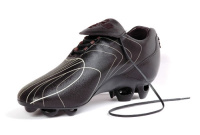Another dimension
For independent designers collaborating with manufacturers, the design process can vary dramatically. Liz Farrelly talks to three leading
designers about their approach to model-making
For independent designers collaborating with manufacturers, the design process can vary dramatically. Liz Farrelly talks to three leading designers about their approach to model-making
For today’s designers working in the fields of product and furniture, flexibility is the key; to win a project from an international manufacturer is one thing, but to collaborate long-term means being able to develop a range of products for that client across materials and markets.
By necessity, that flexibility should be echoed in the designer’s working process, the chain of events that transforms a brief into a concept, and through drawings, models and prototypes, into a solution ready for manufacture. Such a progression does not occur in isolation, but demands give and take between the designer, their studio team, the manufacturer’s in-house technicians and perhaps, out-of-house specialists, including engineers and presentation model-makers. The model, in all its incarnations, is the linchpin of this process, the means of communicating in three dimensions.
In looking at how designers incorporate models into their creative process, it becomes obvious every project is different. For Jasper Morrison, ‘A model may be used at any stage, but generally once we’re sure the concept is valid. Sometimes it is necessary before a drawing, but usually after.’ By contrast, Tom Lloyd of Pearson Lloyd reveals, ‘We use models from the very beginning to the very end.’ And while Morrison has an in-house workshop – ‘I occasionally get my hands dirty’ – he adds that ‘typically, it’s the [manufacturing] company that makes the prototypes’.
The way Jaime Hayón uses models reflects the diversity of projects he is developing, from tableware to architecture, from bathrooms to crystal chandeliers. ‘We make models in foam, polyurethane, wood and plaster. I make concept models; at the studio we make 3D renderings to understand a project, especially an interior. And the client will always make a model before investing in manufacturing, and to test the ergonomics.’
Add in the fact that Hayón is constantly travelling – between clients, a workshop in Treviso, Italy, and his base in London – and digital model-making becomes crucial to the mix: Hayón’s colleagues produce 3D images that are e-mailed direct to his laptop.
As creative director at Spanish porcelain company Lladró, Hayón also works directly with highly trained sculptors, who model his ideas in clay, realising his sketchbook drawings as full-scale objects, which he reviews during fortnightly feedback sessions.
For Pearson Lloyd, a London-based product design consultancy with an emphasis on large-scale furniture and lighting projects and an enviable client list – Walter Knoll, Germany; Allermuir, UK; Artemide, Italy; Steelcase, US – a wide range of models feature in the development process. Lloyd describes the variety as, ‘Fit for purpose… the way we output a model depends on what we need to learn from it, at that particular stage in the project. For ergonomic analysis, understanding the overall scale and developing fine detail, we use full-size models. And depending on the timing, materials vary from scraps of cardboard and tape, to finished appearance models. We also use scale models to develop and check the surface modelling of a product.’
For Pearson Lloyd, mixing up talented individuals and technology produces the best results. ‘Everyone in the studio gets involved in the model-making process. There’s a dynamic dialogue between work carried out in 3D CAD and the hand-modelling process,’ says Lloyd.
Further in the process, models turn into prototypes. ‘We have a small prototyping shop in the studio – again, it’s a vital part of our design process. But this is matched by external model-makers for rapid prototyping and finish appearance models. E-mail allows us to use model-makers around the globe, with one of the finish appearance models for the Soul chair [for Allermuir] being made in Taiwan, from e-mailed information. It was in the studio within ten days.’
Like Morrison and Hayón, Lloyd works with manufacturers from around the world, so Pearson Lloyd’s design process needs to reflect its non-standard requirements. ‘Some clients own and run their manufacturing plants, and have full-service, in-house prototyping and engineering departments. We spend a great deal of time at the factories, having hands-on dialogue over models and prototypes. Others rely on us to deliver a product ready for final engineering, and, in that case, we work with consultant design engineers,’ Lloyd says.
When it comes to using models, there are no set rules. Use them frequently though and it is likely that you will better understand and communicate the issues and your proposed solutions – plus, you will be in good company.
-
Post a comment




